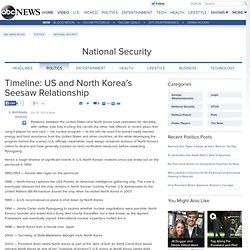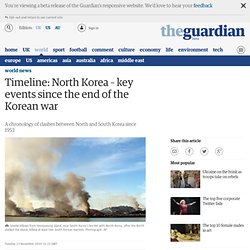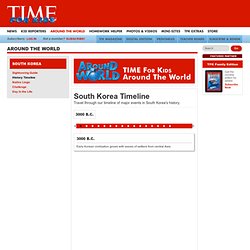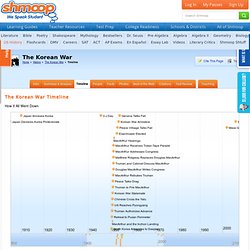

Timeline South Korea. Timeline: US and North Korea’s Seesaw Relationship. Dec 19, 2011 8:04pm Relations between the United States and North Korea have seesawed for decades, with neither side fully trusting the carrots the other had offered.

In recent years, Kim Jong Il played his one card — his nuclear program — to the hilt. He used it to extract badly needed energy and food assistance from the United States and other countries, all the while developing the program behind the scenes. U.S. officials, meanwhile, have always remained dubious of North Korea’s claims to disarm and have generally insisted on strict verification measures before rewarding Pyongyang. Here’s a rough timeline of significant events in U.S. 1950-1953 — Korean War rages on the peninsula 1968 — North Korea captures the USS Pueblo, an American intelligence gathering ship. 1969 — A US reconnaissance plane is shot down by North Korea 1994 — Jimmy Carter visits Pyongyang to explore whether nuclear negotiations were possible. 1998 — North Korea fires a missile over Japan. Timeline: North Korea – key events since the end of the Korean war. 27 July 1953 The war ends when a truce is signed by a representative of the US-backed UN forces, and a representative of North Korea and allied Chinese forces.

South Korea was not a signatory. There is no formal peace treaty, meaning the two countries remain technically at war. The Korean war cost 2 million lives. January 1968 North Korean commandos launch a failed assassination attempt on the then president of South Korea, Park Chung-hee. 15 August 1974 There is another assassination attempt on Park Chung-hee, by a North Korean agent in Seoul. 9 October 1983 North Korean agents target the venue of a visit by South Korean president Chun Doo-hwan to Burma, killing more than 20 people including four South Korean cabinet ministers. 29 November 1987 North Korea blows up a South Korean civilian airliner, killing 115 people. North and South Korea become members of the UN. September 1996 A North Korean submarine lands commandos on the South Korean coast. June 2000 January 2002 February 2005 July 2006. South Korea Timeline. Early Korean civilization grows with waves of settlers from central Asia.

Immigrants from eastern China bring new rice-growing techniques. Korea's emerging states develop laws and a new writing system that uses Chinese characters. The Silla Dynasty brings together three existing kingdoms, and the arts flourish. The Buddhist monk Ilyon writes Samguk Yusa, a classic piece of Korean literature. The Yi Dynasty begins and the country is renamed Choson. The Japanese military ruler Hideyoshi Toyotomi leads invasions of Korea. Japan defeats China in the Sino-Japanese War, ending China's influence over Korea. The Russo-Japanese War ends, and Japan gains control of Korea from Russia. After Japan's surrender at the end of World War II, Korea is divided into north and south zones at the 38th parallel. The Republic of Korea is established in the south, and the Democratic People's Republic of Korea is established in the north.
North Korea invades South Korea. The Korean War Timeline of Important Dates. Japan Declares Korea Protectorate Japan declares a protectorate over Korea.

Japan Annexes Korea Japan formally annexes Korea as a colony. Japanese investments begin to flow into the new colony, turning it into a source of industrial and agricultural wealth for Japan. Jul 1945 Potsdam and Korea By mutual agreement at the Potsdam Conference, the United States and Soviet Union—allies in World War II—make plans to jointly occupy Korea following the defeat of Japan. Aug 10, 1945 Russians Arrive in Korea In the last days of World War II, Russian troops begin moving into northern Korea. Aug 15, 1945 V-J Day Japan surrenders to the Allies, officially ending World War II.
Aug 26, 1945 38th Parallel Soviet forces complete their occupation of northern Korea, halting their southward advance through the country exactly at the 38th parallel, as agreed at the Potsdam Conference. Sep 9, 1945 U.S. in Seoul American forces finally reach Seoul, where they accept the Japanese surrender of southern Korea. Mar 5, 1946 Dr. Timeline of Korean history.